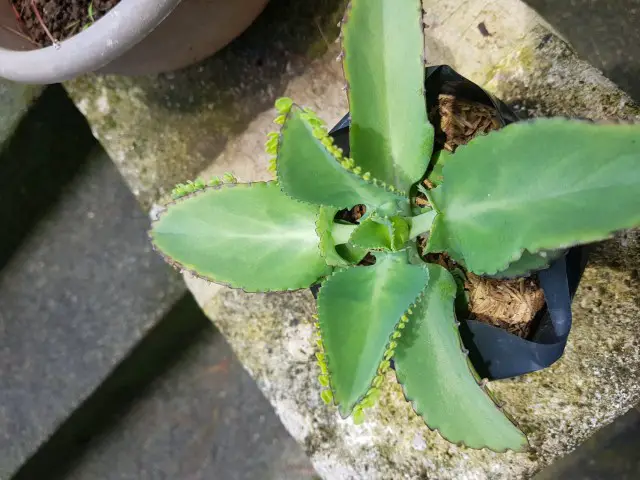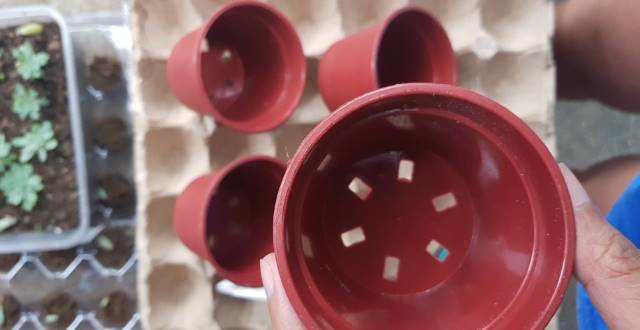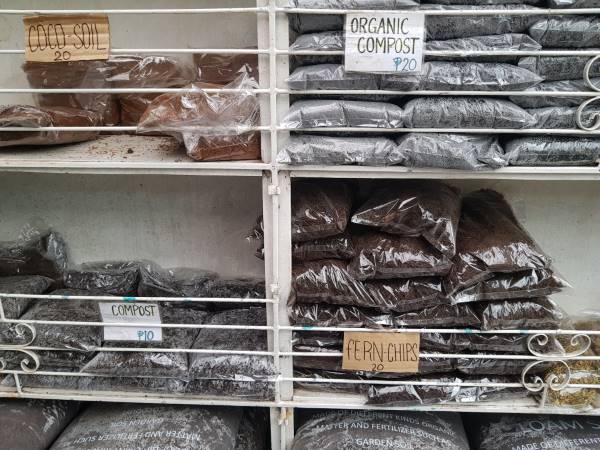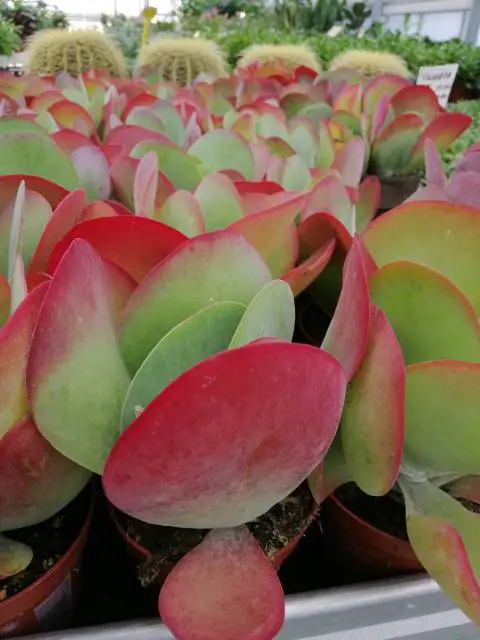Kalanchoe daigremontiana is a well-known, short-lived, monocarpic succulent. This unique plant is also known by the technical name of “Bryophyllum daigremontiana”. It is an aggressively growing invasive species with attractive foliage. This plant is commonly known as Mother of Thousands, Alligator Plant, Devil’s Backbone, and Mexican Hat Plant.
All parts of Kalanchoe daigremontiana contain a toxic steroid known as “daigremontianin”. The plant is often misidentified as Kalanchoe delagoensis the Chandelier plant.
This plant is very easy to propagate and perfect for beginners. Kalanchoe daigremontiana does not possess the ability to produce seeds and reproduces through plantlets only. It is an invasive plant species that grows quite fast and uncontrollably from the dropped plantlets and can go out of hands within no time.
Even if you throw a small plantlet in the trash it will start to grow and spread very soon. If you do not want your garden to be taken over by this invasive plant, be careful do not drop any plantlets in the garden soil.
Origin and distribution
Kalanchoe daigremontiana is native to Androhibolava mountains and Fiherenana River valley in the southwest Madagascar.
Later, it has been introduced to tropical and sub-tropical areas such as the United States, Puerto Rico, Pacific islands, Australia, subtropical Africa, South Africa, India, China, New Zealand, and some parts of the Canary Islands.
It prefers to grow in dry and rocky areas. Due to its invasive growth habit, it threatens the natural ecosystems, particularly in arid and semi-arid areas.
How does Kalanchoe daigremontiana look like?
The overall look of this plant is quite unusual and interesting. It has a simple, erect, brownish stem that grows up to 3 feet tall. The plant has opposite and whorled, oblong-lanceolate phylloclades which grow up to 20 cm (6-8 inches) long and 3.2 cm (1.25 inches) in width. The margins of phylloclades are spoon-shaped bulbiferous spurs that bear plantlets that can start rooting while still attached to the phylloclade. The leaves are 6 inches in length and 3 inches in width.
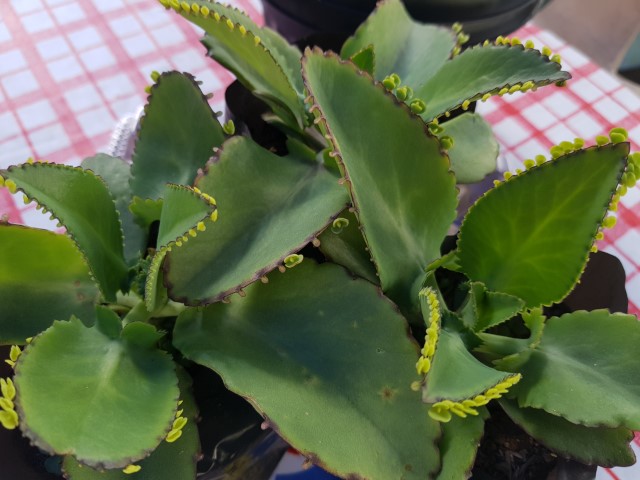
The most notable characteristic of this plant is the baby plantlets or bulbils appearing at the margins of leaves. Each pair of leaves is arranged opposite to each other. Newly emerging leaves pair up at a 90-degree angle from the previous leaves. This arrangement ensures the proper exposure of proper sunlight to all plant leaves.
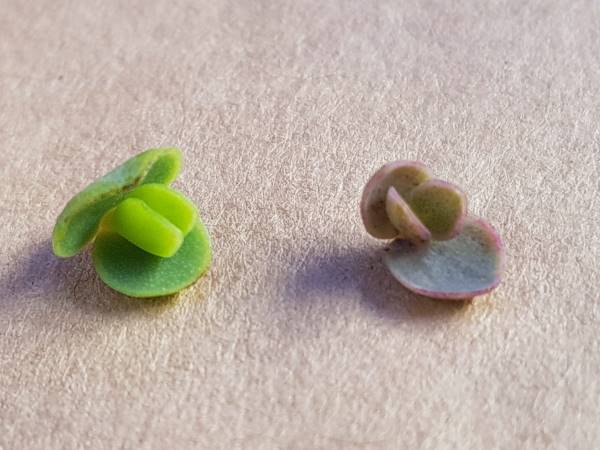
The inflorescence is terminal umbrella-like with grayish pink or sometimes orange or reddish-purple flowers. Flowering occurs sporadically not annually. Flowering is more often observed at the beginning of the summer season particularly in such climates where the seasonal temperature difference is quite variable.
How to grow and care for Kalanchoe daigremontiana?
Kalanchoe daigremontiana is very easy to grow. It requires low care to no care at all. People with a busy work schedule can easily propagate and grow these plants indoors and outdoors. However, you must be careful not to drop any plant parts in the soil or containers where you do not want to grow these plants, as this invasive species will immediately grow and take over the whole space.
Let’s just learn how to grow and care for this wonderful succulent at home.
Light requirements
This succulent likes a good dose of the morning sun. Place the plants under bright indirect sunlight for 6 hours a day. Indoor you can keep your plants near a bright sunny windowsill.
While growing outdoors, keep the plants at a shady place and avoid exposure to direct sunlight.
Do not place your plants outside under the direct afternoon sun. Too much exposure to bright direct sunlight can cause sunburn or sunscald.
Temperature and humidity requirements
It grows between a temperature range of 25 ◦C to 50 ◦F. The temperature beyond this range might affect the normal growth of the plant. In the US it preferably grows in the USDA Zone 9a to zone 11b. The temperature in zones below 9a is too low for growing Kalanchoe daigremontiana.
USDA zones to grow Kalanchoe daigremontiana
- USDA Zone 9b: (25-30 °F) -3.9 to -1.1 °C
- USDA Zone 10a: (30-35 °F) -1.1 to 1.7 °C
- USDA Zone 10b: (35-40 °F) 1.7 to 4.4 °C
- USDA Zone 11a: (40-45 °F) 4.4 to 7.2 °C
- USDA Zone 11b: (45-50 °F) 7.2 to 10 °C
It loves to grow outdoors in the summer season. Be careful gradually move your plants outdoors, otherwise, it might cause sunscald or scorching of leaves. In this way, your plants will acclimatize to the temperature change.
Kalanchoe daigremontiana is very sensitive to frost and cannot tolerate freezing temperatures. Therefore, the plants must be kept outdoors only where there is no danger of frost otherwise keep the plants indoors to protect from frost damage. The freezing temperature causes tissue damage and kills the plants in no time.
It likes to grow in humid conditions and can take any amount of humidity. But be warned it hates the soggy soil.
Water requirements
The watering needs are typical like many other succulents. It is an amazing xerophytic (requires very low water) plant. This succulent is a desert plant and survives prolonged periods of drought. It can survive without water for a considerably long time. But regular watering enhances the performance of this plant.
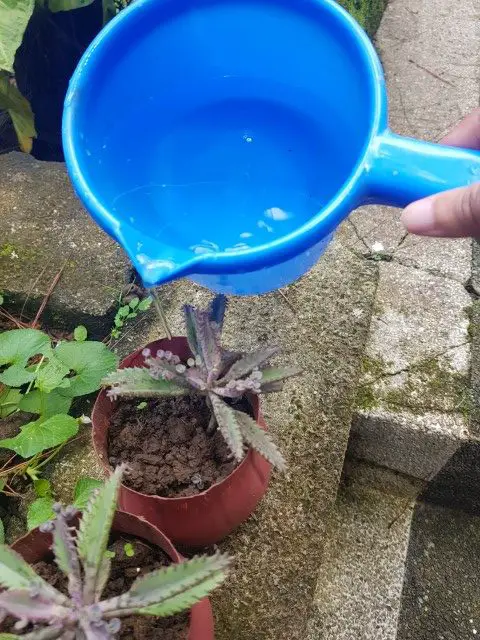
Water the plants regularly in the actively growing season during spring and summer. Apply water less often during the fall and winter seasons.
Provide moderate watering throughout the year, water your plants less often during winter. Use the “soak and dry” method to water your plants. Give your plants a full drink of water once. Allow the top 1 to 2 inches of soil to dry completely before applying the next irrigation.
While watering, make sure to apply water in the soil only and try not to wet the leaves. If a few drops of water accidentally spill onto the leaves immediately absorb the water from the leaves.
Kalanchoe daigremontiana hates overwatering. So, do not overwater ever because it can cause rotting of roots.
Soil
A commercial cactus potting mix is best for the plants. Kalanchoe daigremontiana likes to grow in a well-drained potting medium. If you are using a standard succulent mix must add some sand or extra perlite to provide better drainage.
The pH of the soil is not a big issue. It is fine even if you do not monitor the pH of the soil as it can take any level of pH.
Fertilization
This plant does not need frequent fertilization like other succulents. If you want to fertilize your plants just apply a balanced dose of fertilizer once a month.
Give a balanced dose of liquid fertilizer during the growing season 2 to 3 times.
During periods of high temperatures and more water supply, Kalanchoe daigremontiana requires more nutrition. If you do not provide balanced nutrition the phylloclades will show typical deficiency symptoms such as pustule-like lesions, and crippled growth.
Propagation
Kalanchoe daigremontiana propagates so easily. The small plantlets start rooting readily wherever they fall on the ground. You can propagate this plant by using bulbils, leaf, and stem cuttings. Seed propagation is not a viable method for this plant. Although leaf or stem cuttings also do fine. Propagation through plantlets is the easiest way.

Pluck a small bulbil or plantlet from the mother plant by gently pulling it from the leaf, or take a stem or leaf cutting. You can also use sharp scissors or garden shears to take the plant parts for propagation. Let the plant parts dry or develop callous for 2 to 3 days.
Do not plant the cuttings immediately as the moisture in the plant parts can cause rotting.
Take a standard succulent potting mix. Fill the potting mix in clean pots. The soil must be well-drained and slightly moist. Make a hole at the center of the growth medium and place the cuttings in the hole. Start misting the cuttings immediately after planting them with a shower or sprinkler. Cover the plants with polyethylene sheets to retain moisture.
The cutting will start rooting after 2 weeks. Gently pull the cuttings to observe the development of roots.
Once the newly developed roots of your Kalanchoe daigremontiana reach up to 1 inch in length, transfer them to new containers.

For the first few weeks treat your plants as baby seedlings and avoid exposure to direct sunlight, low temperature, and drought conditions.
Once your plants become established in the growth medium care for them like mature Kalanchoe daigremontiana plants.
Repotting or transplanting
Kalanchoe daigremontiana does not require to be repotted. However, in case the plantlets fall in the containers and start growing wildly, take the baby plants and transfer them to new pots.
Gently pull the baby or young plants from the containers. Do not rush while pulling the plants as you might damage them. Fill the clean containers with a standard succulent potting mix and transfer the plants to new containers. Provide extra care until the plants establish in the containers.
Pruning
Pruning is generally not required. But pruning the dead or decayed leaves, spent blooms, and damaged stems help to ensure good growth during the next growing season.
Snip off the stems after flowering to encourage new and healthy growth. Pruning can also help you to limit the growth of this invasive plant up to a certain limit. Simply cut off the overgrowing plant parts to ensure better growth.
Pruning will also make your plants look neat and clean.
Is Kalanchoe daigremontiana toxic?
Like all other succulents, Kalanchoe daigremontiana is safe to humans but toxic to pet animals, birds, and livestock. But still, the plants must be kept out of the reach of toddlers because it can cause stomach upset.
The toxicity of this plant is due to the cardiac glycoside “daigremontianin”. All parts of the plant are toxic if ingested. Keep the plants away from cats and dogs because if they eat up any plant part it can lead to serious consequences.
The pets will start developing several symptoms after ingestion. Keep an eye on the pet, it might show the following symptoms such as diarrhea, vomiting, change in heart rate, stomach upset or pain, and excessive slobbering after ingestion.
If you observe the symptoms of poisoning do not waste time at all take your pet immediately to an expert Veterinarian. He might induce vomiting to flush out the poison from the animal’s stomach.
Insect pests and diseases
Although Kalanchoe daigremontiana is quite a pest-resistant, it is often attacked by some insect pests and diseases. These sucking pests love to feed on thick juicy leaves of Kalanchoe daigremontiana. It can be attacked by aphids, scales, and mealybugs.
Use a neem oil spray to repel the insect pests away. You can also use a cotton swab dipped in alcohol to wipe your plants. The alcohol is beneficial to keep the insects away from the plants. Some insecticides are also available in the market. You can buy a nontoxic insecticide and spray it on the plants.
It is better to get rid of these tiny pests at an earlier stage. They can be quite problematic if left untreated and can cause significant damage.
Fungal diseases like powdery mildew and root rot also appear on the plants. The root rot fungus usually attacks due to overwatering. The fungus can rapidly kill your plants. Make sure to keep the soil well-drained.
Read our Article about Mother of millions here.
Bottom line
Kalanchoe daigremontiana is an attractive invasive plant. These plants are less common indoors and can be planted very well outdoors.
The beautiful small plantlets appearing at the margin of leaves make them quite appealing. They can be easily propagated using the small plantlets and does not require any special care.
You will often find extra plants to pop out in your containers or garden soil. Thankfully it is easy to remove these plants.
Do not expose your plants to intense direct sunlight and overwatering as it damages the plant and can cause death. Also, try to save your plants from the damaging insect pests.
A healthy growing Kalanchoe daigremontiana will surely make you fall in love with it.

